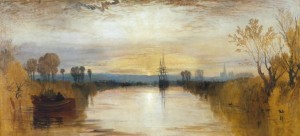I can’t wait for spring! It is still pretty chilly in the Midwest, but I know the sunny, warm days will be here very soon.
Can you imagine what it would be like if spring never came? That is what happened one year during the Regency period. In fact, 1816 is often referred to as the “Year Without a Summer,” and during this time extreme weather dramatically effected England’s cultural and economic landscape. Let’s take a quick look:
In April 1815, the volcano Mount Tambora erupted on the island of Sumbara in the Dutch East Indies (Indonesia). The force of the blast launched ash, dust and debris into the atmosphere. The impact was so significant that temperatures lowered globally and the sun’s rays were blocked, making the days appear darker. The altered atmosphereic conditions affected weather and agriculture worldwide, especially in Canada, northeastern United States, and northern Europe.
As a result, 1816 ranks as one of England’s coldest winters on record. The snow fell as late as May in London, and in the Lake District, snow was still on the highest peaks at the end of July. The excessive precipitation and unseasonably cold temperatures devastated crops. Consequently, food shortages were rampant. To make matters worse, farm laborers were not working, and with thousands of soldiers returning from foreign wars, unemployment was a major problem. Rioting looting broke out all over the country. Malnutrition and cold, wet conditions led to a rise in disease.

But even during this time of darkness, the artists and poets of the day found beauty in the midst of the shadows. The gloomy, bitter weather inspired Byron’s haunting poem Darkness. Byron said he “wrote it… at Geneva, when there was a celebrated dark day, on which the fowls went to roost at noon, and the candles were lighted as at midnight.” And in the world of art, J. M. W. Turner is said to have been inspired by the spectacular sunsets that resulted from the high levels of debris and ash in the atmosphere.
Curious about what else was going on in England at this time? To give you a frame of reference, here is a quick snapshot of England’s literary scene during the cold, raw months of 1816:
— Jane Austen’s Emma published. (actually published in December 1815, but the title page says 1816)
–Lord Byron’s poem Darkness, The Siege of Corinth, and Prometheyus are published.
–Samuel Taylor Coleridge’s Kubla Kahn is published.
–Percy Bysshe Shelley’s Alastor: Or, The Spirit of Solitude is published.
–John Keat’s O Solitude and On First Looking into Chapman’s Homer are published .
—Charlotte Bronte is born on April 21st.
Thanks for stopping by Regency Reflections. Enjoy the spring and summer months ahead!
Originally posted 2013-03-29 10:00:00.
Comments are closed.